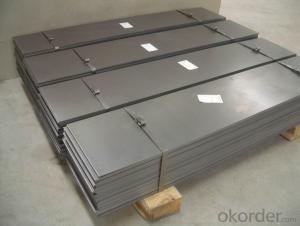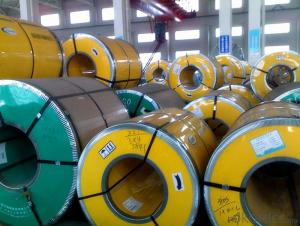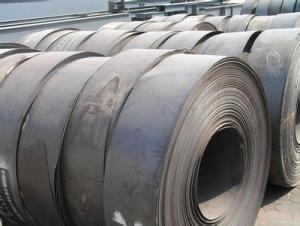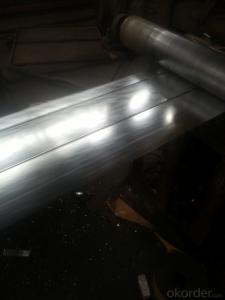Hot Rolled Steel Strip Electrical Appliance Bridge Pipeline Automobile
- Loading Port:
- China main port
- Payment Terms:
- TT OR LC
- Min Order Qty:
- 1000 m.t.
- Supply Capability:
- 10000 m.t./month
OKorder Service Pledge
OKorder Financial Service
You Might Also Like
Structure of Hot Rolled Steel Strip Description
JIS G3131 SPHC\SPHD ASTM A659
HR/Hot Rolled Steel Strip/Band
Hot rolled stieel is a semifinished product obtained from the hot rolling of slabs or billets and is produced for conversion by cold rolling. Cold rolled steel is manufactured from hot rolled, annealed and pickled strip by cold rolling on polished rolls. Depending on the thickness desired, the cold rolling requires various numbers of passes through the mill to effect the necessary reduction and to secure the desired surface characteristics and mechanical properties.
For machinery manufacturing, container manufacturing, automobile, shipbuilding
Main Features of the Hot Rolled Steel Strip
Good quality with hot rolled
Images Hot Rolled Steel Strip
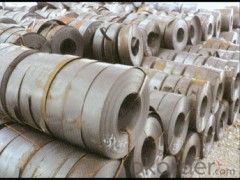

Specification Hot Rolled Steel Strip
JXC
1.25mm-6mm*10mm-600mm
AISI,ASTM,BS,DIN,GB,JIS
Q195,Q215,Q215B,Q235,Q235B
FAQ of Hot Rolled Steel Strip
We offer insurance for quality with low price
We can provide qualify goods,competitive price and speedy delivery
Seawory Export Package Inside:Moisture-proof paper Outside:Iron sheet Use Strip tie for 8 times .
- Q:How do steel strips compare to other materials in terms of flexibility?
- Steel strips are typically less flexible compared to other materials due to their high tensile strength and stiffness.
- Q:Are steel strips suitable for the manufacturing of cookware?
- Yes, steel strips are suitable for the manufacturing of cookware. Steel is a durable and versatile material that offers excellent heat conductivity and even distribution. It can withstand high temperatures and is resistant to rust and corrosion, making it ideal for cooking purposes. Additionally, steel strips can be easily shaped and molded into various cookware designs, allowing for the creation of different types and sizes of pots, pans, and other kitchen utensils.
- Q:What are the different tolerances for steel strips?
- There are various tolerances for steel strips, depending on the specific application and industry requirements. Some common tolerances include thickness tolerance, width tolerance, flatness tolerance, and surface finish tolerance. These tolerances ensure the steel strips meet the desired specifications and can vary depending on the manufacturing process and intended use of the strips.
- Q:Can steel strips be used for making architectural components?
- Yes, steel strips can be used for making architectural components. Steel strips are versatile and can be easily shaped and molded to create various architectural elements such as panels, frames, trims, and decorative features. Additionally, steel offers excellent strength, durability, and resistance to corrosion, making it a suitable material choice for architectural components that need to withstand various environmental conditions.
- Q:Are steel strips suitable for high-precision applications?
- Steel strips can be suitable for high-precision applications, depending on the specific requirements of the application. Steel strips offer excellent strength, durability, and dimensional stability, making them suitable for various precision applications. However, factors like the quality of the steel, surface finish, and manufacturing process must be considered to ensure the desired level of precision.
- Q:How do steel strips perform in structural components?
- Steel strips perform very well in structural components due to their high strength and durability. They provide excellent load-bearing capacity, resistance to deformation, and are capable of withstanding heavy loads and extreme conditions. Steel strips also offer versatility in design and can be easily shaped and welded, making them suitable for a wide range of structural applications.
- Q:Can steel strips be used for making heat exchangers?
- Yes, steel strips can be used for making heat exchangers. Steel is often chosen for its excellent heat conductivity and durability, making it a suitable material for constructing heat exchanger components such as tubes or fins.
- Q:How do steel strips contribute to fire resistance in various applications?
- The fire resistance of different applications is improved by the presence of steel strips, which contribute through structural integrity and fire containment. Steel possesses inherent fire resistance due to its high melting point and low thermal conductivity. When utilized as strips or reinforcements, steel has the ability to enhance the fire resistance of diverse materials and structures. Construction commonly employs steel strips in the form of fire-resistant coatings or as reinforcing elements within concrete structures. Fire-resistant coatings that contain steel strips create a barrier that shields the underlying material from heat and flames. These coatings possess the capability to delay the spread of fire, provide insulation, and prevent structural collapse. Concrete structures also benefit from the inclusion of steel strips in enhancing fire resistance. When embedded in concrete, steel reinforcement bars or strips increase the structure's strength and durability. In the event of a fire, the steel strips aid in maintaining the concrete's structural integrity, preventing it from crumbling or collapsing under high temperatures. Moreover, steel strips are frequently utilized in fire doors and fire-rated partitions. These strips offer additional strength and stability to the doors and partitions, rendering them more fire-resistant and hindering the spread of flames and smoke. Steel strips in fire doors can also function as thermal barriers, reducing heat transfer and safeguarding the surrounding areas. In industrial applications, steel strips are employed in the manufacture of fire-resistant cables. These cables are engineered to endure high temperatures and retain their functionality during fire emergencies. Steel strips within the cables provide mechanical strength and protection against heat, ensuring that critical electrical systems remain operational in environments prone to fire. In conclusion, steel strips fulfill a crucial role in enhancing fire resistance across various applications, providing structural support, containment, and insulation. Whether utilized in coatings, concrete reinforcement, fire doors, or fire-resistant cables, steel elevates the overall fire resistance of materials and structures, ultimately safeguarding lives and property in the event of a fire.
- Q:What are the different types of heat treatments for steel strips?
- There are several types of heat treatments for steel strips, including annealing, quenching, tempering, and case hardening. Annealing involves heating the steel to a high temperature and slowly cooling it to relieve internal stresses and improve its ductility. Quenching rapidly cools the steel to increase its hardness and strength. Tempering is a process that follows quenching to reduce the brittleness of the steel and improve its toughness. Case hardening involves adding a hard outer layer to the steel while keeping the core soft and ductile.
- Q:How are steel strips protected against corrosion?
- Steel strips are protected against corrosion through various methods such as galvanization, where a layer of zinc is applied to the surface to act as a barrier against corrosive elements. Additionally, they can be coated with protective paints or oils, or undergo a process known as electroplating, where a thin layer of another metal is deposited on the steel surface to provide corrosion resistance. Regular maintenance, including cleaning and proper storage, is also crucial in preventing corrosion.
1. Manufacturer Overview |
|
|---|---|
| Location | |
| Year Established | |
| Annual Output Value | |
| Main Markets | |
| Company Certifications | |
2. Manufacturer Certificates |
|
|---|---|
| a) Certification Name | |
| Range | |
| Reference | |
| Validity Period | |
3. Manufacturer Capability |
|
|---|---|
| a)Trade Capacity | |
| Nearest Port | |
| Export Percentage | |
| No.of Employees in Trade Department | |
| Language Spoken: | |
| b)Factory Information | |
| Factory Size: | |
| No. of Production Lines | |
| Contract Manufacturing | |
| Product Price Range | |
Send your message to us
Hot Rolled Steel Strip Electrical Appliance Bridge Pipeline Automobile
- Loading Port:
- China main port
- Payment Terms:
- TT OR LC
- Min Order Qty:
- 1000 m.t.
- Supply Capability:
- 10000 m.t./month
OKorder Service Pledge
OKorder Financial Service
Similar products
New products
Hot products
Hot Searches
Related keywords





















